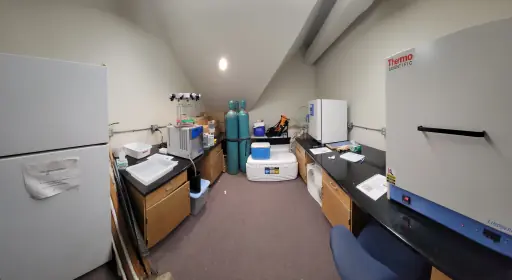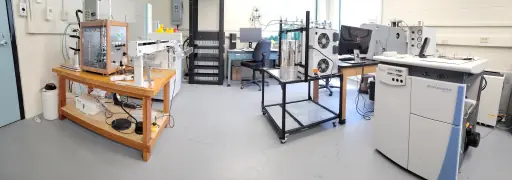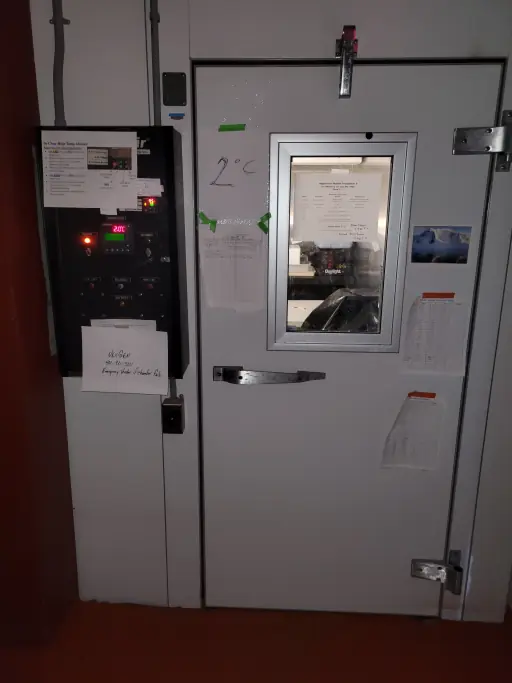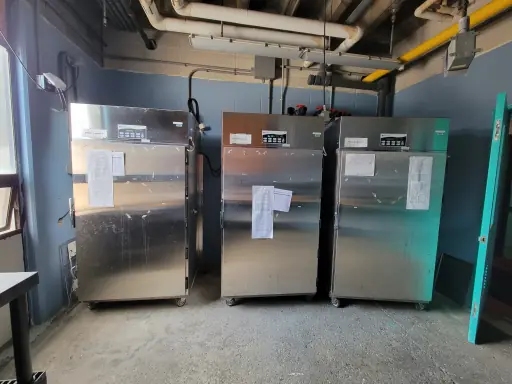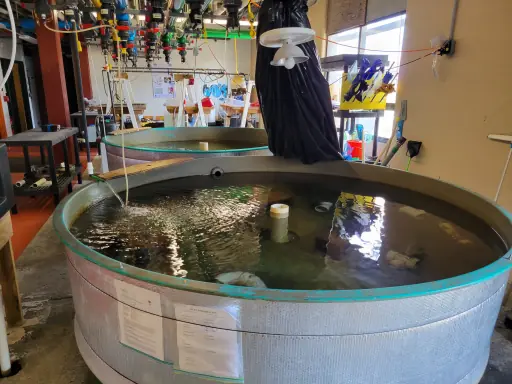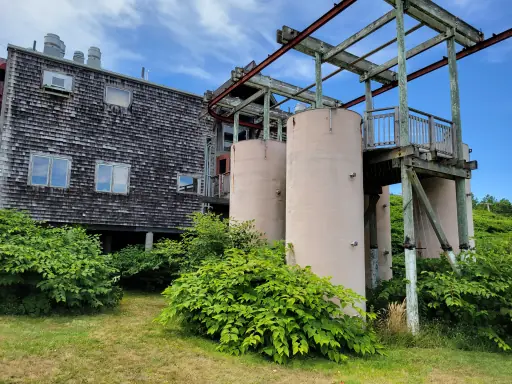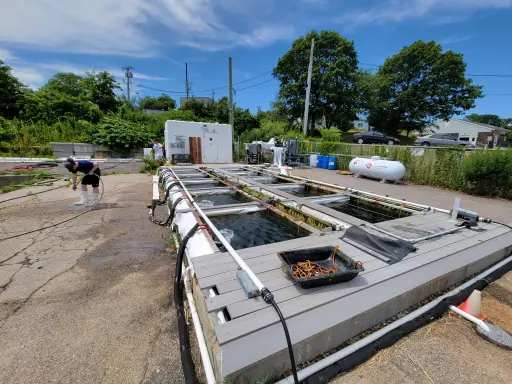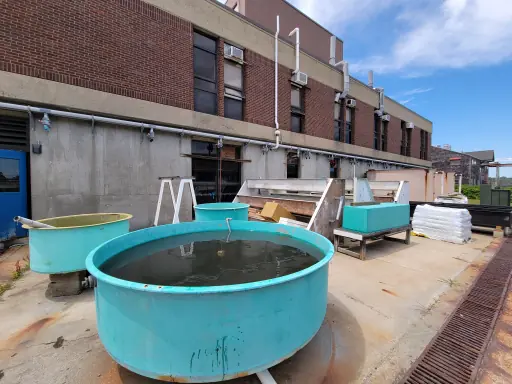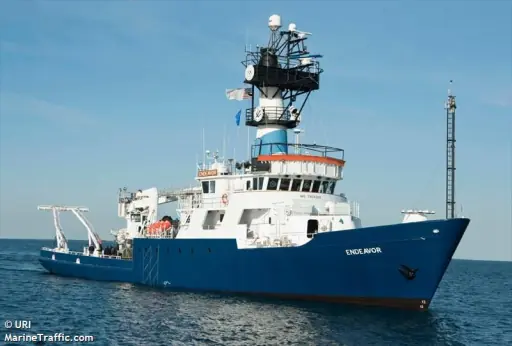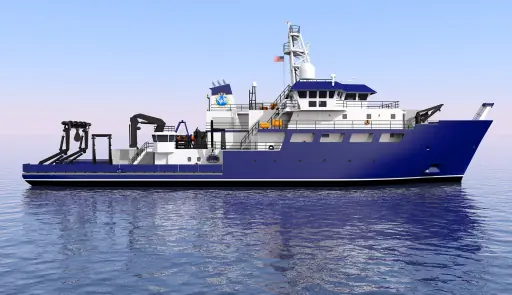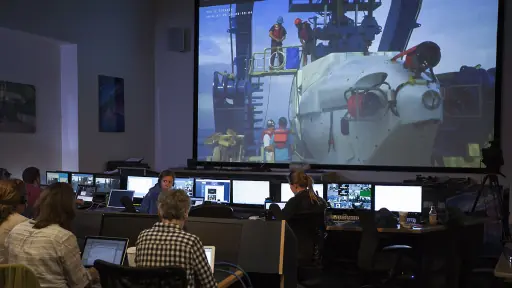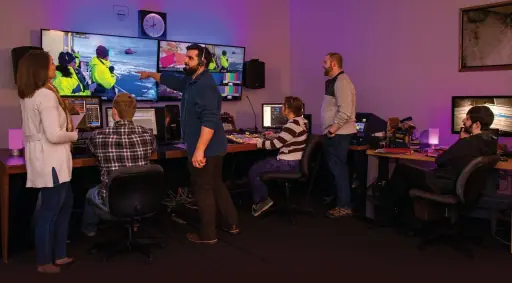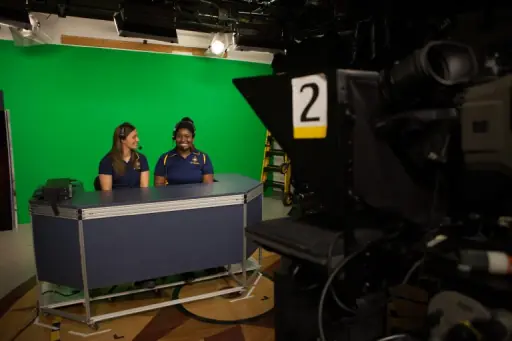McMahon Ocean Ecogeochemistry Lab
We have three well-equipped lab spaces dedicated to all aspects of sample preparation and analysis of biological samples for stable isotope analysis. These labs are located on the third floor of the Coastal Institute Building of URI’s Narragansett Bay Campus (NBC). They are in the same building and same floor as the McMahon Lab offices to facilitate efficient workflow and collaboration. As part of the NBC Master Renovation Plan the McMahon Ocean Ecogeochemistry Lab and the collaborative Robinson Biogeochemistry and Paleoceanography Lab, both with shared stable isotope facilities, will be co-located to a state-of-the-art shared stable isotope facility in a new research building planned for the NBC in 2023-2025 timeframe.
Lab Space One
Lab Space One contains a drying/ hydrolysis oven, freeze drier, and muffle furnace for sample drying and glassware combustion.
Lab Space Two
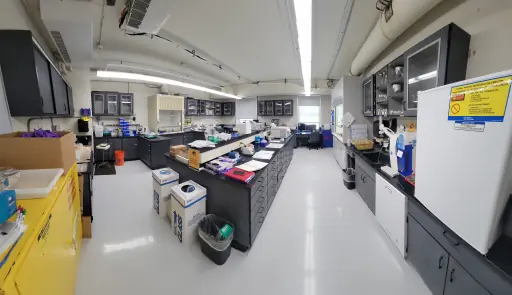
Lab Space Two is designed sample processing and wet chemistry. This lab has instrumentation for all aspects of compound-specific stable isotope sample preparation, including an Omni Bead Ruptor Elite tissue homogenizer, microbalances, centrifuges, Milli-Q water system, ion exchange column apparatus, reactivap heating blocks with N2 blown systems, and two fume hoods for organic chemistry). This lab has multiple dissecting and compound microscopes computer linked to HD cameras for image analysis. This lab also has a computer-controlled New Wave MicroMill (Photo “Micromill”) designed for submicron precision milling to recover sample powder for chemical and isotopic analysis of archival biological tissues (e.g., teeth, otoliths, shells, baleen, coral skeletons) (Photo “Skeleton Processing”).
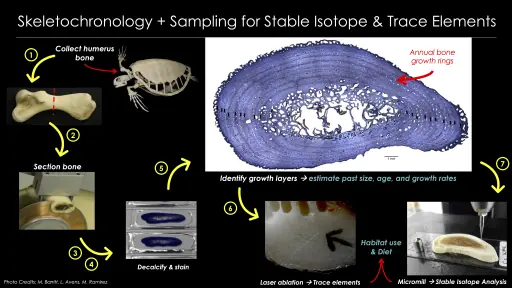
Lab Space Three
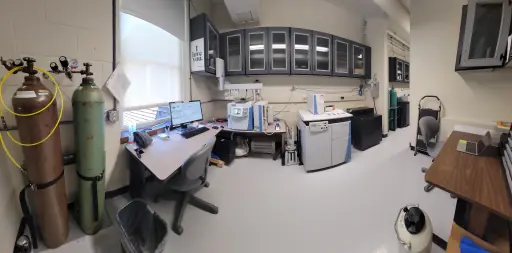
Lab Space Three is a dedicated instrument lab for compound-specific stable carbon and nitrogen isotope analysis, with a Gas Chromatograph IsoLink II linked via ConFlo-IV Interface to a DELTA V Plus Mass Spectrometer (Hi Pace, CNOS + HD). This space is adjacent to Lab Space Two but physically separated and independently climate controlled to ensure optimal environmental conditions for mass spectrometry. This space also has a dedicated fume hood for sample dilution.
Collaborative URI-GSO Isotope Facility
The Robinson Biogeochemistry and Paleoceanography Lab at URI-GSO has a collaborative isotope facility in the Center for Atmospheric Chemistry Sciences (CACS) Building on the Bay Campus. There two additional IRMSs in the lab that expand the research and analytical capacity of our group.
Through a successful NSF MRI grant (PIs Robinson, McMahon), we have recently acquired a brand new DeltaV-Plus IRMS. It is currently coupled with a custom gasbench front end (Photo “GB_IRMS”) for measuring natural abundance δ15N and δ18O of nitrous oxide gas produced by denitrifying bacteria. A custom ‘heart-cut’ gasbench (Photo “Custom_GB”) is under construction to nearly double our current sensitivity for dN15 and dO18 of nitrous oxide via con-flow. There is a second Delta V Advantage IRMS that is dedicated to a Costech 4010 elemental analyzer (Photo “EA”) for combustion of solid materials to CO2 and N2 for bulk isotopic analysis.
Marine Science Research Facility
The Marine Science Research Facility (MSRF) on the NBC serves as a platform for scientific research as well as undergraduate, graduate, and postdoctoral training. The MSRF facilities and instruments are available to researchers through an RI NSF EPSCoR cost-center. The MSRF has state-of-the-art laboratories for performing chemical, physical, and molecular analyses of samples. The MSRF has a number of instruments focused on water chemistry analysis (e.g., Lachat nutrient analyzer, dissolved gas analysis using a Membrane Inlet Mass Spectrometer), imaging (e.g., Nikon Eclipse Ni-U epifluorescence microscope and digital camera system DS-Ri1, Olympus dissecting stereomicroscope SZX16, Nikon inverted microscope Eclipse TS100, and Stingray Camera for microscopes), and Quantitative PCR. The MSRF facility has a dedicated technical staff to assist in equipment training, consultation on experimental design and implementation, sample analysis, and educational outreach and public tours.
The MSRF also has an 8,000 ft2 indoor flow-through seawater aquarium facility with capacity for incubation, culturing, micro, and mesocosm organismal experiments. Bay water is pumped throughout the facilities and can be delivered chilled or heated and raw or filtered. Salinity also may be manipulated. This facility has specialty wet-labs for pathology and transgenic research. There are two “polar” and two “temperate” EnvironAir 100 ft2 custom-built walk-in environmental chambers
and six Percival custom-built upright biological incubators.
There are a wide array of tanks for organismal growth, feeding, and environmental condition experiments, including: individual, flow through aquaria arrays; multiple 10’ dia grow tanks,
and four 4,300 L (1.8m dia, 5.5m height) custom-built, environmentally controlled mesocosm tanks.
The facility also has a pier, four seawater intake pipes, a pump house, marsh mesocosm,
and numerous outdoor tanks.
The facility has a walk-in -20 freezer and laminar flow tank.
R/V Endeavor and R/V Narragansett Dawn
URI-GSO is the host institution for Research Vessel Endeavor, one of three intermediate class National Science Foundation-owned ships designed from the keel up as oceanographic research vessels. The Endeavor was built in 1976 with a major mid-life refit in 1993. The ship is 185 ft, carries a crew of 12 and accommodates up to 18 scientists and technicians, and has a 30 day endurance. The ship has operated throughout the Atlantic Ocean, ranging as far north as the Svalbard Archipelago in Norway and south to Tristan de Cunha, from the Caribbean and Gulf of Mexico into the Pacific Ocean to Easter Island and Hawaii. The main deck is outfitted with two overboarding frames (A-Frame: 20,000 lbs instrumentation capacity and J-Frame: 18,000 lbs instrumentation capacity). There’s also 1,300 ft2 of wet, dry, and chemistry lab space. Endeavor was the first in the nation’s academic fleet to convert its propulsion, electrical generation, and heating systems to burn cleaner renewable biodiesel and it also utilizes 100% biohydraulic fluids. After nearly five decades of oceanographic service, the R/V Endeavor is retiring from the active working fleet.
Starting in 2023, the R/V Narragansett Dawn will the new $125M intermediate class research vessel hosted by URI-GSO. Narragansett Dawn acknowledges the Indigenous peoples’ histories, ancestors, and perseverance in our communities today. This research vessel is currently being built from the keel up as a next generation oceanographic research and education platform. The ship will be 200’ and have 30% more science space than its predecessor the R/V Endeavor. The final design trades away reliance on larger, traditional fixed laboratories in favor of a mix of flexible fixed-laboratory space and a large, open aft deck that can accommodate more laboratory vans to suit the mission at hand. This ship will have full-time, high-speed satellite connectivity for communications, internet access and data transfer, including telepresence between researchers at sea and colleagues, students, and the general public on shore. The arrival of the R/V Narragansett Dawn will bring with it three major construction projects—a new, larger pier that is resilient to sea level rise, a centralized marine operations facility, and an academic facility dedicated to research and development of ocean robotics.
Inner Space Center
The Inner Space Center (ISC) is a one-of-a-kind national facility based at URI-GSO that supports live ocean exploration via telepresence technology.
The ISC is home to a diverse team of ocean scientists, engineers, education professionals, and video producers.
The team works with cutting-edge technology to facilitate, capture, produce, and promote at-sea, underwater, aerial, and laboratory exploration in real time. The ISC Studio is a fully-equipped video shooting location, equipped with microphones and cameras that are tied directly into the broadcast and recording systems.
This facility contains professional video switchers, mixers, QC monitors, intercoms, video editing and dubbing stations, and guest operating space in which partners can perform a full range of production activities (scripting, editing, teleprompting, etc.). The ISC connects diverse audiences to a global network of exploration in real time and enables scientists and students to participate remotely in expeditions while engaging with the general public to enhance the broader impacts of their research.
URI Colab for Research Computing
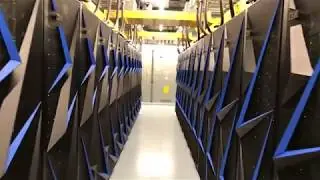
URI’s Information Technology Services and GSO’s on-hand Systems Development and Computer Center Manager (Phil Teixeira) provide on campus computer support and troubleshooting expertise. URI’s High performance Research Computing facility currently support three major clusters:
- Unity is a cluster hosted at Massachusetts Green High Performance Computing Center that is a partnership with URI and UMass.
- Andromeda is the current on-premise cluster available for researchers.
- Seawulf is available for educational use, such as classes.
